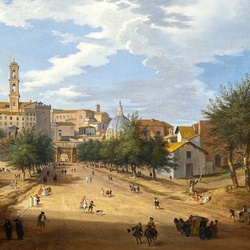Giovanni Paolo Panini
Giovanni Paolo Panini (Giovanni Paolo Pannini) (1691 - 1765) - Italian painter of the Rococo era, master of the landscape-vedi. Born in Piacenza around 1692. In the mid-10s of the 18th century, Panini moved to Rome, where ancient ruins inspired him to create historical compositions, scenes from contemporary life and imaginary views of real buildings located in different parts of the city, but brought together.
He gained fame for his paintings at the Villa Patrizi (completed in 1725) and decorations for the feast in honor of the birth of the Dauphin (1729, Louvre, Paris; 1731, Dublin).
Imagined or written off from life, his compositions, sometimes very impressive, are “pieces of life”, placed in the environment of ancient ruins and modern monuments of Rome (Piazza Santa Maria Maggiore, 1742, Rome, Palazzo Quirinale). Pannini's works are one of the most magnificent testimonies of the 18th century. Gifted with an exceptional talent as a stage designer, Pannini in his works attached great importance to the interpretation of space; his compositions are almost always distinguished by an extraordinary spatial breadth and scope. Comparing the grandiose space with the most detailed characteristics of the characters inhabiting his scenes, the artist achieves very effective contrasts, especially when depicting various ceremonies.
The greatest successor of Pannini's art, who inherited his taste for ancient ruins, was also the Frenchman - Hubert Robert.






